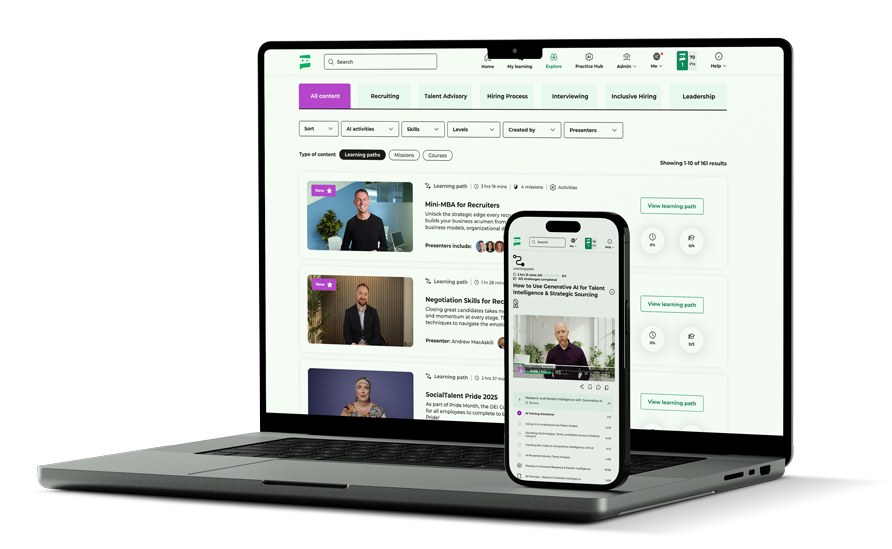
By Johnny Campbell
It’s happening in every TA leadership meeting I walk into.
The same pause. The same question. The same knot in people’s faces:
“We know our TA function isn’t fit for what’s coming. But what should it actually look like and how do we get there?”
I actually heard it again this week from a TA team in a large, highly regulated enterprise. What started as a routine check-in turned into something else entirely – a full-blown strategy session on the future of talent acquisition. And it wasn’t theoretical in their eyes. It was real. Urgent. Necessary.
We’re past the point of tinkering. This isn’t about tweaking workflows or trialling a new CRM. It’s about fundamentally rebuilding how TA operates, where it sits in the business, and what it’s accountable for. Because when AI strips away the admin, and hiring becomes more complex – not less – your team has two choices:
Be a service desk. Or become a strategic lever.
First: Burn the Old Org Chart
The one-team-fits-all recruiter model? Dead. The full-stack recruiter juggling 40 reqs and three industries? Gone. (I can hear the celebrations!)
High-performing TA teams are re-architecting around what actually works and it all centres around specialization, trust, and speed.
The goal isn’t necessarily to have fewer people. It’s to have the right people doing the right things – backed by tech that handles the rest. Here’s the new shape I’m seeing across the most forward-thinking TA teams:
1. Business-Facing Talent Advisors
These people aren’t reactive. They’re upstream.
They’re involved in workforce planning, headcount forecasting, internal mobility, and talent strategy. They’re the ones asking:
- Why are we hiring for this role?
- Could we redeploy talent internally instead?
- How does this align with our transformation roadmap?
Think of them like enterprise account managers. They don’t own requisitions. They own relationships – with business leaders, with HR partners, with Finance. With automation and enablement in place, one advisor can guide 100+ hires a year.
But the value isn’t in volume. It’s in their ability to shape demand, reduce mis-hires, and make better talent decisions before a single candidate is contacted.
2. Candidate-Facing Recruiters
These recruiters aren’t admins. They’re market and role experts who specialize in a single talent segment – whether that’s engineers, private bankers, clinicians, or compliance officers. They speak that specific language. They know the top players. They know what flies and what doesn’t. And they build credibility fast.
Essentially, they act more like career coaches than coordinators, trusted partners who guide candidates through these life-changing decisions. And with hiring managers? They influence outcomes, negotiate offers, and navigate complexity.
Their impact isn’t measured by how many reqs they process. It’s defined by how effectively they influence, negotiate, and close. They don’t just recruit. They win talent.
3. TA Enablement & Specialists
This is the function most orgs overlook, the machines behind-the-scenes that quietly drive everything forward. Think:
- TA Ops & Analytics: The process, compliance, automation, and insight layer. Think Sales RevOps, but for hiring.
- Employer Brand: The team shaping your story across every touchpoint in the funnel.
- Specialist Pods: Executive search, early careers, DEI – roles that still need bespoke, high-touch care.
This layer doesn’t just support the work. It multiplies it.
And Then: Let AI Take the Work It Deserves
We talked about this in-depth in the newsletter recently, but if you’re still thinking about AI as a “just another tool”, you’re already behind. AI is becoming a team member. Fast.
Already, it’s absorbing entire chunks of the hiring process:
- Job ads and specs? AI-written.
- Inbound and outbound sourcing? Done.
- Screening? Voice or text-based AI agents.
- Scheduling, offer generation, rejections? All handled.
- Compliance logs and audit trails? Captured automatically.
But that’s just the warm-up. What’s next is agentic interviewing – AI that builds, runs, and scores your interviews. Screening calls are already shifting. Behavioural interviews aren’t far behind. This isn’t a someday thing. It’s live right now.
So… How Do You Build This?
This is where most leaders freeze. They see the vision but the “how” feels too big, too risky, too hard to sell. Here’s how I break it down with teams that are making real moves:
1. Start With Experience, Not Tools
Define the hiring experience you want and then build backwards. How should it feel for candidates? Hiring managers? Recruiters? Then pilot things like interview intelligence or AI job spec building in a corner of the business. One function. One region. Just enough to learn and iterate.
2. Automate the Early Funnel
This is where you get your time back. Use AI to source. To screen. To schedule. To reject. To move. You’ll be shocked by what disappears. In my opinion, 95% of this early funnel activity can be automated in a way that scales AND improves.
3. Reshape the Team
With the admin gone, shift the humans to where they matter. More candidate engagement. More strategic advising. Fewer generalists. More specialists. And all this equals? Higher impact.
4. Bring in Agents
Use AI for interview planning. For assessments. For hiring manager prep. Maybe in the right roles you might skip the interview altogether and run simulations instead?
5. Operationalize
This is the long game. Here is when you build a real TA Ops team and upskill your hiring managers to be comfortable using AI tools. Track the ROI and make the change sustainable.
This Isn’t About Replacing Recruiters. It’s About Making Them Unignorable.
What’s happening in TA right now mirrors what Sales went through a decade ago.
Admin vanished. Enablement exploded. And the humans who stayed? They became more valuable, not less. Because humans do what only humans can do: build relationships, craft strategy, earn trust.
We’re not just hiring better people – we’re building smarter organizations. And if we do this right, TA won’t be seen as “support” anymore. It will be a true strategic lever.
This is the moment. Let’s not miss it.



